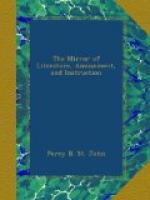The bay is a bold and deep shore exposed to the open sea: from the banks or cliffs a clean gravel runs to the sea terminating in a hard sand, free from every mixture of ooze, and those offensive beds of mud, so frequently found at the mouths of rivers, and on many shores.
The town is built on a rising hill with a south-east exposition; defended towards the north by hills, whose ascent is easy, and view pleasing; bounded on the west by a fruitful and extensive cornfield, descending gently from the Downs to the banks of the sea, and leading to Shoreham; and on the east by a most beautiful lawn called the Steine, which runs winding up into the country among hills, to the distance of some miles.
The soil here, and over all the south Downs, is a chalk rock covered with earth of various kinds and depths in different places.
The country round Brighthelmston is open and free from woods, and finely diversified with hills and valleys. Hence the advantage of exercise may be always enjoyed in fair weather: it is ever cool on the hills, and a shelter may be constantly found in the valleys from excess of wind.
The hills are in some places steep, but everywhere covered with a green sward from the bottom to the top.[2] On the summit of these the prospect is extensive and varied; towards the sea there is an uninterrupted view from Beachy-head to the Isle of Wight; towards the land, or weald side, the view, in the opinion of the great Mr. Ray, is no where to be equalled; and from this very prospect, compared with that of the Isle of Ely, he infers the wisdom of God in the construction of hills.
The Downs here run parallel to the sea; the turf of them is remarkably fine; they are from six to ten miles broad: so that this delightful country cannot be deemed a confined one.
The merit of the situation of this town has within these few years attracted a great resort of the principal gentry of this kingdom, and engaged them in a summer residence here. And there is reason to believe, that in the earliest times it was in the highest estimation. The altars of the Druids, the only surviving remains of the ancient Britons, are no where to be seen in greater number.[3] And although there are here no traces of temples, no images here existing, yet does not their want in any shape invalidate the supposition of this place’s having been an original residence of theirs, as it seems to have been a received principle in all countries where Druidism prevailed, that the confining the Deity within walls, or the representing him in any human figure, were unworthy of his majesty, and unsuitable to his immensity. But the position of these altars, and the local circumstances answering so exactly to their customary choice of places, leave but little room to doubt of their having had a residence here.
The attachment of our ancestors to this place may be further illustrated by our taking a view of the efforts they made to preserve it.




